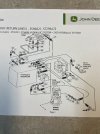ts360
Active Member
My 690ELC got water in the hydraulic oil at some point and I've been struggling with it ever since. I think I've fixed where it was coming from(boom lift cylinders) but changing the oil in the tank never makes it any better. I know there is a lot of oil in the rest of the system but I would have thought that it would eventually clear up with multiple tank changes but it never does. I suppose I have two questions, is there anything that can be added to a system this large that anyone has had any luck with getting rid of water? And if that is not an option, does anyone have any advice to flushing a system like this? Thank you for any info

